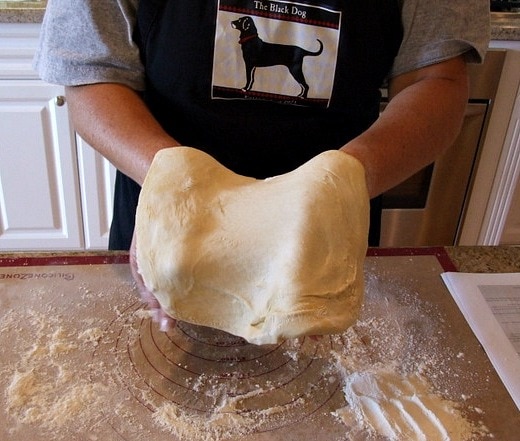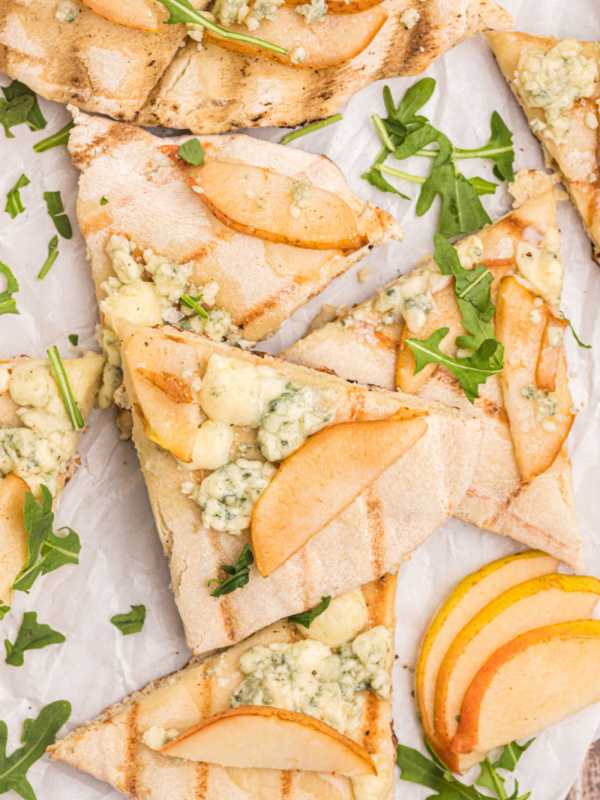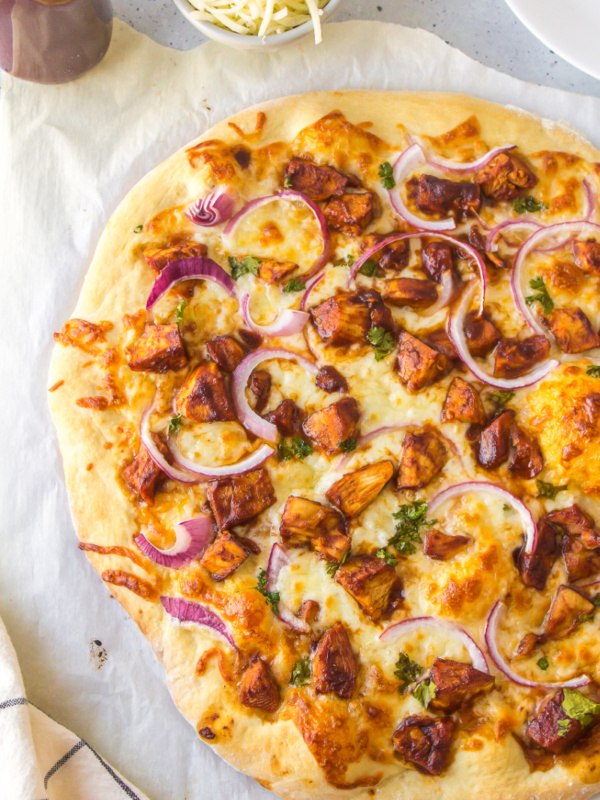This Basic Pizza Dough recipe is perfect for making the best pizza.

Basic Pizza Dough
The recipe turns out 6 balls of dough that can be frozen to make whenever the pizza-mood strikes. Since we like our crust a little on the thick side, I separate my batch into 3 balls of dough instead.
🛒Ingredients needed:
- flour
- salt
- yeast
- oil
- water
- sugar
- semolina/durum flour or cornmeal
✏️How to make Basic Pizza Dough:
*The complete, printable recipe with all ingredients and instructions is at the end of this post.
-
Mix together the flour, salt and yeast in a big bowl (or in the bowl of your stand mixer).
-
Add oil, sugar and cold water and mix well (with the help of a large wooden spoon or with the paddle attachment, on low speed). You want to form a sticky ball of dough. On a clean surface, knead for about 5 to 7 minutes, until the dough is smooth and the ingredients are homogenously distributed. If it is too wet, add a little flour (not too much, though) and if it is too dry add 1 to 2 teaspoons of extra water. (NOTE: if you are using an electric mixer, switch to a dough hook and mix on medium speed for the same amount of time. The dough should clear the sides of the bowl but stick to the bottom of the bowl. If the dough is too wet, sprinkle in a little more flour, so that it clears the sides. If, on the contrary, it clears the bottom of the bowl, dribble in a teaspoon or two of cold water. The finished dough should be springy, elastic, and sticky, not just tacky, and register 50° to 55°F.)
-
Flour a work surface or counter. Line a jelly roll pan with baking paper/parchment. Lightly oil the paper.
-
With the help of a metal or plastic dough scraper, cut the dough into 6 equal pieces (or larger if you plan to make larger pizzas). (NOTE: to avoid dough from sticking to scraper, dip scraper into water between cuts).
-
Sprinkle some flour over the dough. Make sure your hands are dry and then flour them. Gently round each piece into a ball. (NOTE: if the dough sticks to your hands, dip your hands into the flour again).
-
Transfer the dough balls to the lined jelly roll pan and mist them generously with spray oil. Slip the pan into a plastic bag or cover with plastic wrap.
-
Put the pan into the refrigerator and let dough rest overnight or for up to three days. (NOTE: you can store the dough balls in zippered freezer bags if you want to save some of the dough for any future baking. In that case, pour some oil (a few Tablespoons only) in a medium bowl and dip each dough ball into the oil so that it is completely covered in oil. Then put each ball into a separate bag. Store the bags in the freezer for no longer than 3 months. The day before you plan to make pizza, remember to transfer the dough ball from the freezer to the refrigerator).
-
On the day you plan to eat pizza, exactly 2 hours before you make it, remove the desired number of dough balls from the refrigerator. Dust the counter or mat with flour and spray lightly with oil. Place dough balls on the floured surface and sprinkle them with flour. Dust your hands with flour and delicately press the dough into disks about ½-inch thick and 5 inches in diameter. Sprinkle with flour and mist with oil. Loosely cover the dough rounds with plastic wrap and then allow to rest for 2 hours.
-
At least 45 minutes before making the pizza, place a baking stone on the lower third of the oven. Preheat the oven as hot as possible (500°F). (NOTE: if you do not have a baking stone, use the back of a jelly roll pan, but do not preheat the pan).
-
Generously sprinkle the back of a jelly roll pan with semolina/durum flour or cornmeal. Flour your hands (palms, backs and knuckles). Lift up 1 piece of dough by lifting it with a pastry scraper. Lay the dough across your fists in a very delicate way and carefully stretch it by bouncing it in a circular motion on your hands and by giving it a little stretch with each bounce. Once the dough has expanded outward, move to a full toss. (NOTE: During the tossing process, if the dough tends to stick to your hands, lay it down on the floured counter and reflour your hands, then continue the tossing and shaping. If you have trouble tossing the dough or if the dough never wants to expand and always springs back, let it rest for approximately 5 to 20 minutes in order for the gluten to relax fully, then try again. You can also resort to using a rolling pin, although it isn’t as effective as the toss method.
-
When the dough has the shape you want (about 9 to 12″ in diameter for a 6 ounce piece of dough), place it on the jelly roll pan, making sure there is enough semolina/durum flour or cornmeal to allow it to slide and not stick to the pan.
-
Lightly top it with sweet or savory toppings of your choice.
-
Slide the garnished pizza onto the stone in the oven (or bake it directly on the jelly roll pan). Close the door and bake for 5 to 8 minutes. (NOTE: after 2 minutes of baking, take a peek. For even baking, rotate 180°).
-
Take the pizza out of the oven and transfer it to a cutting board or your plate. In order to allow the cheese to set a little, wait 3 to 5 minutes before slicing or serving.
Although this is a bit of a ‘process’ to make (in terms of the long, detailed directions included in the recipe), I really think it is an excellent basic dough. I love the fact that it makes several balls of dough that store well in the freezer too.
➡️Recipe Tips:
- Don’t forget that this dough is meant to sit in the refrigerator overnight.
- Then, after sitting out for a couple hours, the dough then becomes pliable and relaxed enough to stretch out gently on the tops of your hands.
- You don’t always need to make a round pizza. Go with any size that works for you, whether a big rectangle, an oval, or smaller individual sized circles.
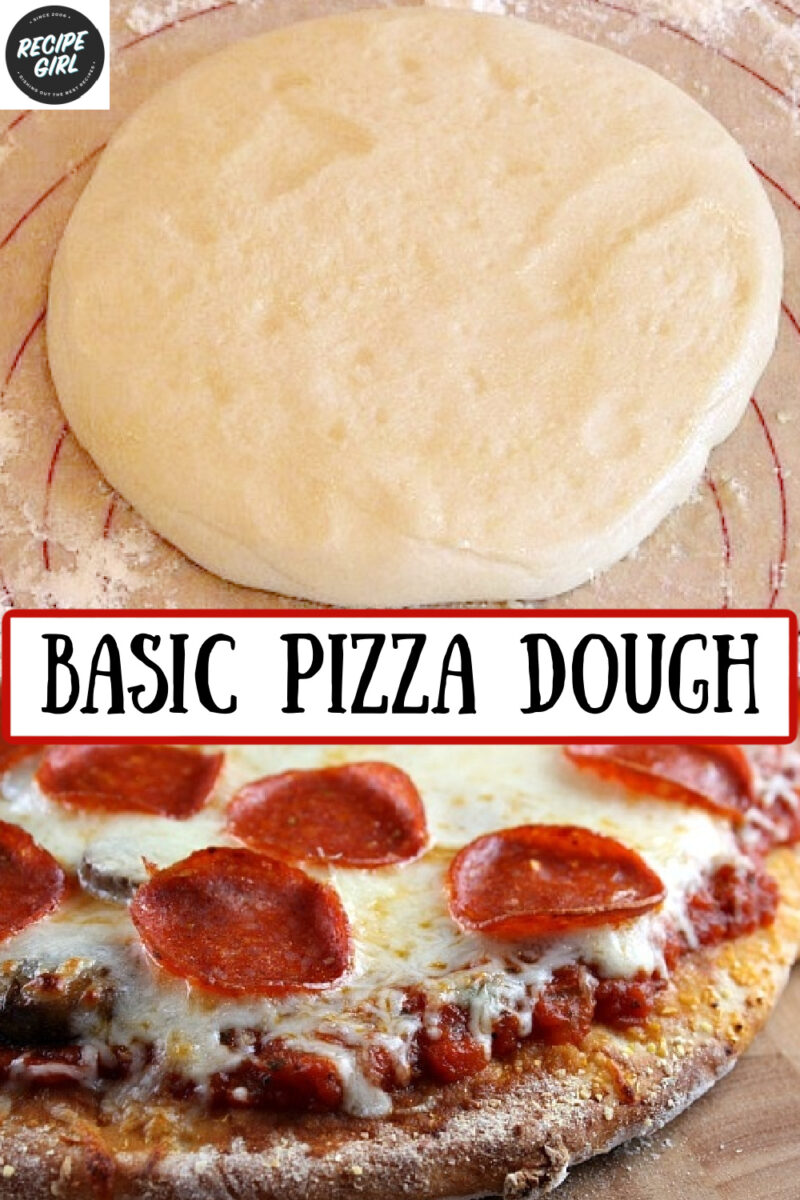
✔️What to do with Basic Pizza Dough:
- Besides traditional pizza, try making a dessert pizza with butter and some sugar and cinnamon sprinkled on top.
- If you’re a fan of calzones, this dough should work beautifully. Try it with my Chicken Cordon Bleu Calzones
- Use it at a children’s birthday party. Make individual sized mini-pizzas, offer an array of toppings and let each child make their own custom pizza!
★How to Store:
The dough can be stored in the refrigerator for up to three days and in the freezer for up to three months. (See recipe for more details on freezing.
❤️Why I love this recipe:
- It’s so versatile!
- I love that it makes enough to use now and also to save some for later.
- It’s a delicious crust, but it still lets the toppings shine.
Recipes using pizza dough:
- Sausage and Scrambled Egg Pizza
- Classic Pepperoni Pizza
- Pizza Dough Garlic Knots
- Cheesy Soppressata Pull-Apart Bread
- Meatball Pizza
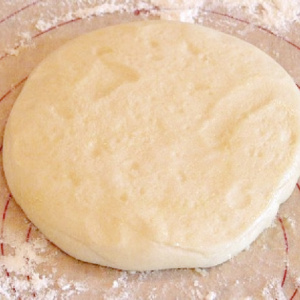
Basic Pizza Dough
Ingredients
- 4½ cups unbleached bread flour or all-purpose flour (chilled)
- 1¾ teaspoons salt
- 1 teaspoon active dry yeast
- ¼ cup olive oil or vegetable oil
- 1¾ cups ice cold water (40°F)
- 1 tablespoon granulated white sugar
- semolina / durum flour or cornmeal, for dusting
Instructions
- Mix together the flour, salt and yeast in a big bowl (or in the bowl of your stand mixer).
- Add oil, sugar and cold water and mix well (with the help of a large wooden spoon or with the paddle attachment, on low speed). You want to form a sticky ball of dough. On a clean surface, knead for about 5 to 7 minutes, until the dough is smooth and the ingredients are homogenously distributed. If it is too wet, add a little flour (not too much, though) and if it is too dry add 1 to 2 teaspoons of extra water. (NOTE: if you are using an electric mixer, switch to a dough hook and mix on medium speed for the same amount of time. The dough should clear the sides of the bowl but stick to the bottom of the bowl. If the dough is too wet, sprinkle in a little more flour, so that it clears the sides. If, on the contrary, it clears the bottom of the bowl, dribble in a teaspoon or two of cold water. The finished dough should be springy, elastic, and sticky, not just tacky, and register 50° to 55°F.)
- Flour a work surface or counter. Line a jelly roll pan with baking paper/parchment. Lightly oil the paper.
- With the help of a metal or plastic dough scraper, cut the dough into 6 equal pieces (or larger if you plan to make larger pizzas). (NOTE: to avoid dough from sticking to scraper, dip scraper into water between cuts).
- Sprinkle some flour over the dough. Make sure your hands are dry and then flour them. Gently round each piece into a ball. (NOTE: if the dough sticks to your hands, dip your hands into the flour again).
- Transfer the dough balls to the lined jelly roll pan and mist them generously with spray oil. Slip the pan into a plastic bag or cover with plastic wrap.
- Put the pan into the refrigerator and let dough rest overnight or for up to three days. (NOTE: you can store the dough balls in zippered freezer bags if you want to save some of the dough for any future baking. In that case, pour some oil (a few Tablespoons only) in a medium bowl and dip each dough ball into the oil so that it is completely covered in oil. Then put each ball into a separate bag. Store the bags in the freezer for no longer than 3 months. The day before you plan to make pizza, remember to transfer the dough ball from the freezer to the refrigerator).
- On the day you plan to eat pizza, exactly 2 hours before you make it, remove the desired number of dough balls from the refrigerator. Dust the counter or mat with flour and spray lightly with oil. Place dough balls on the floured surface and sprinkle them with flour. Dust your hands with flour and delicately press the dough into disks about ½-inch thick and 5 inches in diameter. Sprinkle with flour and mist with oil. Loosely cover the dough rounds with plastic wrap and then allow to rest for 2 hours.
- At least 45 minutes before making the pizza, place a baking stone on the lower third of the oven. Preheat the oven as hot as possible (500°F). (NOTE: if you do not have a baking stone, use the back of a jelly roll pan, but do not preheat the pan).
- Generously sprinkle the back of a jelly roll pan with semolina/durum flour or cornmeal. Flour your hands (palms, backs and knuckles). Lift up 1 piece of dough by lifting it with a pastry scraper. Lay the dough across your fists in a very delicate way and carefully stretch it by bouncing it in a circular motion on your hands and by giving it a little stretch with each bounce. Once the dough has expanded outward, move to a full toss. (NOTE: During the tossing process, if the dough tends to stick to your hands, lay it down on the floured counter and reflour your hands, then continue the tossing and shaping. If you have trouble tossing the dough or if the dough never wants to expand and always springs back, let it rest for approximately 5 to 20 minutes in order for the gluten to relax fully, then try again. You can also resort to using a rolling pin, although it isn't as effective as the toss method.
- When the dough has the shape you want (about 9 to 12" in diameter for a 6 ounce piece of dough), place it on the jelly roll pan, making sure there is enough semolina/durum flour or cornmeal to allow it to slide and not stick to the pan.
- Lightly top it with sweet or savory toppings of your choice.
- Slide the garnished pizza onto the stone in the oven (or bake it directly on the jelly roll pan). Close the door and bake for 5 to 8 minutes. (NOTE: after 2 minutes of baking, take a peek. For even baking, rotate 180°).
- Take the pizza out of the oven and transfer it to a cutting board or your plate. In order to allow the cheese to set a little, wait 3 to 5 minutes before slicing or serving.
Nutrition
Nutrition information is automatically calculated, so should only be used as an approximation.

